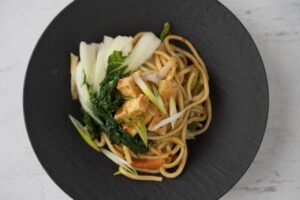
Vegan Food Standards
Defining Vegan
Vegan: a person whose diet excludes any products of animal origin. Similar to a vegetarian diet, a vegan diet is free from animal flesh (meat, fowl, fish or shellfish) and other ingredients resulting from the slaughter of animals. However, a vegan diet is also free from all other animal products, such as eggs, dairy or honey.
Individuals may choose to adhere to a vegan diet for many reasons such as animal welfare, environmental sustainability and personal health and well-being. Individuals who choose to eat a vegan diet often refrain from use of any animal products or by-products in other aspects of their life such as leather, fur, silk, wool, cosmetics containing animal products, or anything that has been tested on animals.

Vegan Standard Guidelines
In Canada, there are no government regulations or guidelines for vegetarian or vegan labeling. However there are independent agencies that can be referenced for nationally and internationally recognized vegan standards and guidelines.
VegeCert is a Canadian non-profit organization that certifies vegan and vegetarian products so that consumers can feel secure that the products they are purchasing are in line with their beliefs. VegeCert’s guidelines have been formulated in consultation with the Toronto Vegetarian Association, a Canadian leader in vegetarianism. Below is an extensive list of animal products that would disqualify food from being categorized as vegan-safe. This list should be consulted when deciding if a food should be labeled as ‘Vegan’.
Animal Products
- Items obtained direct from the slaughter of animals – fish (including anchovies), game and their derivatives (e.g. meat/fish extracts and stocks), poultry, meat etc.
- Marine animal products – ambergris, capiz, caviar(e), chitin, coral, fish scales, fishmeal, isinglass, marine oils and extracts (e.g. fish oils, shark oil (squalene or squalane), seal oil, whale oil), natural sponge, pearl, roe, seal meat, shellfish, sperm oil, spermaceti wax, whale meat
- Animal milks and animal milk derivatives – casein, caseinates, lactates, lactic acid, lactose
- Bee products – bee pollen, bee venom, beeswax, honey, propolis, royal jelly
- Dairy products and by-products – butter, cheese, whey, yogurt
Eggs – hen, quail, duck, ostrich
Slaughter By-Products
- Animal fats (e.g. dripping, lard, suet, tallow), amino acids, aspic, bone, bone charcoal, bone-meal, bristles, collagen, down, dried blood, fatty acid derivatives, gelatin(e), glycerin(e)/glycerol, hoof & horn meal, oleic acid, oleoic oil, oleostearin, pepsin, proteins (e.g. elastin, keratin, reticulin), rennet, skins, stearates, stearic acid, stearin(e)
Animal-Derived Additives
- E120 cochineal
- E542 edible bone phosphate
- E631 sodium 5′-inosinate
- E901 beeswax
- E904 shellac
- Calcium mesoinositol hexaphosphate
- Lactose
- Sperm oil
- Spermaceti
Miscellaneous
- Amniotic fluids, animal and fish glues
- Carmine/carminic acid, catgut, chamois, cochineal, crushed snails or insects
- Fixatives (e.g. musk, civet, castoreum)
- Hormones (e.g. estrogen, progesterone, testosterone)
- Products fortified with vitamin D3 (derived from sheeps wool)
- Any carriers (gelatine is sometimes used to carry beta-carotene and D2), processing aids (lactose is often used to fix flavour in crisps)
Preparation and prevention of cross-contamination
During storage, preparation, cooking and display, vegan food must not come into contact and be contaminated with non-vegan foods. The Vegan Society and The Vegetarian Society provide helpful guidelines to avoid cross-contamination. Below is a combined list of their recommendations on avoiding cross-contamination.
- Wash and dry your hands before handling vegan food.
- When using gloves to pick up food, gloves should always been changed when moving from meat/fish to non-meat products.
- If possible dedicate an appropriate number of work surfaces to the preparation of vegan foods; otherwise clean work surfaces thoroughly before preparing vegan food.
- Separate deep fat fryers should be used or, if that’s not possible, the oil should be changed.
- Care should be taken when grilling or barbequing so that vegetarian products do not come into contact with meat products. If possible, use a separate grill or barbeque. If that’s not possible, ensure that there are distinctive sides to the grill/barbeque for vegetarian products and ensure that meat fat cannot splatter onto non-meat products.
- Ensure separate woks are used for frying. It is not sufficient to wipe out the wok after stir-frying prawns for example. Separate woks should be used for non-meat products.
- Separate cooking and serving utensils (cutting boards, knives, spoons, tongs, etc.) should be used for cooking non-meat products. Color coding utensils ensures their uses are designated to their respective purposes.
- Separate serving plates should be used. For example, a tray of cut sandwiches should not contain meat/fish sandwiches and non-meat sandwiches.
Conclusion
If a food item meets the above guidelines in its ingredients, preparation and serving it can be labeled as ‘Vegan’. Introducing a vegan label to the University of Toronto, St. George campus, allows for easier identification of vegan options for individuals following vegan or vegetarian diets and will also be useful to anyone wishing to reduce their intake of animal products.
For a list of locations that offer vegan entrees, visit our Food Map!
Not sure what to eat?
Need dietary advice?
Have questions about nutrition?






